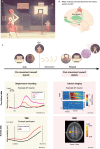Reward signals in the motor cortex: from biology to neurotechnology
- PMID: 39900901
- PMCID: PMC11791067
- DOI: 10.1038/s41467-024-55016-0
Reward signals in the motor cortex: from biology to neurotechnology
Abstract
Over the past decade, research has shown that the primary motor cortex (M1), the brain's main output for movement, also responds to rewards. These reward signals may shape motor output in its final stages, influencing movement invigoration and motor learning. In this Perspective, we highlight the functional roles of M1 reward signals and propose how they could guide advances in neurotechnologies for movement restoration, specifically brain-computer interfaces and non-invasive brain stimulation. Understanding M1 reward signals may open new avenues for enhancing motor control and rehabilitation.
© 2025. The Author(s).
Conflict of interest statement
Competing interests: The authors declare no competing interests.
Figures



Similar articles
-
Cortical neurons multiplex reward-related signals along with sensory and motor information.Proc Natl Acad Sci U S A. 2017 Jun 13;114(24):E4841-E4850. doi: 10.1073/pnas.1703668114. Epub 2017 May 30. Proc Natl Acad Sci U S A. 2017. PMID: 28559307 Free PMC article.
-
Reinforcement Learning based Decoding Using Internal Reward for Time Delayed Task in Brain Machine Interfaces.Annu Int Conf IEEE Eng Med Biol Soc. 2020 Jul;2020:3351-3354. doi: 10.1109/EMBC44109.2020.9175964. Annu Int Conf IEEE Eng Med Biol Soc. 2020. PMID: 33018722
-
The Role of Primary Motor Cortex: More Than Movement Execution.J Mot Behav. 2021;53(2):258-274. doi: 10.1080/00222895.2020.1738992. Epub 2020 Mar 20. J Mot Behav. 2021. PMID: 32194004 Review.
-
Spike prediction on primary motor cortex from medial prefrontal cortex during task learning.J Neural Eng. 2022 Jul 29;19(4). doi: 10.1088/1741-2552/ac8180. J Neural Eng. 2022. PMID: 35839739
-
Latent Factors and Dynamics in Motor Cortex and Their Application to Brain-Machine Interfaces.J Neurosci. 2018 Oct 31;38(44):9390-9401. doi: 10.1523/JNEUROSCI.1669-18.2018. J Neurosci. 2018. PMID: 30381431 Free PMC article. Review.
Cited by
-
Assessing the utility of Fronto-Parietal and Cingulo-Opercular networks in predicting the trial success of brain-machine interfaces for upper extremity stroke rehabilitation.medRxiv [Preprint]. 2025 Apr 11:2025.04.08.25325026. doi: 10.1101/2025.04.08.25325026. medRxiv. 2025. PMID: 40297442 Free PMC article. Preprint.
References
Publication types
MeSH terms
LinkOut - more resources
Full Text Sources
Miscellaneous

